A roof rack might seem like an unnecessary addition to an SUV, especially considering that most body-on-frame sport-utility vehicles are already large enough to accommodate plenty of cargo inside.
Still, even the biggest three-row SUVs lose a significant amount of storage space when those seats are occupied. Take, for example, one of the longest sport-utility vehicles currently available—it can haul over 130 cubic feet of cargo when both the second- and third-row seats are folded flat.
However, once those seats are filled with passengers, that interior cargo space is slashed by 67 percent. That’s when an exterior storage solution, such as a roof rack, becomes essential. With that in mind, Autobytel has put together a list of 10 top SUVs that come factory-equipped with practical roof-mounted storage racks.
Chevrolet Tahoe and Suburban
Like many SUVs that feature roof racks, the Chevrolet Tahoe and its longer sibling, the Chevy Suburban, are fitted with standard luggage-rack side rails. For those opting for the upscale LTZ trims, Chevrolet adds a touch of luxury with bright chrome trim on the side rails.
These complement other high-end exterior elements, including “standard 20-inch polished-aluminum wheels, bodycolor moldings, chrome-accented assist steps and high-intensity discharge headlamps”; meanwhile, “black roof rails are standard for all other trim levels.”
Regardless of trim, the side rails can be outfitted with crossbars and a wide range of roof-mounted cargo accessories like bike, luggage, and kayak carriers.
Importantly, none of these features interfere with the vehicles’ built-in connectivity, such as “standard mobile Wi-Fi hotspots, 4G LTE connectivity, and smartphone-integration technologies.”
The 2025 Chevrolet Tahoe remains a full-size SUV built on a truck platform, offering substantial space for both passengers and cargo, along with impressive towing capabilities.

Thanks to its robust body-on-frame construction and powerful engine lineup—which includes “a choice of two V-8s and a diesel inline-six”—the Tahoe stands out as an excellent option for those in need of a capable tow vehicle. For those looking to venture off the pavement, the Z71 trim is designed to “tackle off-road trails” with ease.
Inside, the Tahoe provides three rows of seating that can accommodate “up to nine,” and the interior configuration can be tailored to your preferences, ranging from “relatively spartan” to “nearly lavish.”
That said, none of the available trim levels quite reach the upscale refinement seen in its mechanically related counterparts—“the GMC Yukon Denali or the ritzy Cadillac Escalade.”
At the front of the cabin, a prominent infotainment screen takes center stage on the dashboard, “angled slightly toward the driver” for easier access. As expected, both “Apple CarPlay and Android Auto are included,” ensuring modern connectivity is part of the package.
While alternatives like “the Ford Expedition, the Jeep Wagoneer, and the Nissan Armada” offer comparable feature sets, the Tahoe stands apart with “superior on-road refinement,” a trait that we not only value, but believe other drivers will as well.
And for those who find even the Tahoe a bit too small for their needs, Chevrolet has a solution in the form of its long-wheelbase sibling. “If the Tahoe isn’t large enough for you, its long-wheelbase sister ship, the Suburban, is ready and waiting to haul more of everything.”
Also Read: Top Engines That Outlived the Brands That Made Them
Nissan Armada
The Nissan Armada adopts the same platform used in the globally respected Nissan Patrol, a rugged SUV known worldwide for its durability.
This transition results in the Armada having one of the highest roof weight capacities among SUVs with roof racks, with side rails capable of holding up to 220 lb. The model also introduces a more powerful V8 engine, now generating “a best-in-class 390 horsepower—an increase of 23 percent versus last year’s Armada V8.”
Alongside its performance improvements, the new Armada showcases a more contemporary design, featuring “bold V-Motion grille and standard chrome trim,” as well as “bodycolor exterior accents and dark-finish roof rails.”
In today’s world—where electric sport-utility vehicles are becoming increasingly common—it may be difficult to recall a time when large, V-8-powered, body-on-frame SUVs like the Nissan Armada were some of the most sought-after vehicles on the road.
Emerging during the early 2000s, an era when Americans were snapping up vehicles like the Hummer H2 and Ford Excursion, the original Armada—and its Infiniti counterpart, the QX56—was built using the same platform as Nissan’s full-size Titan pickup.
Much has changed in the years since. Vehicles like the Hummer and Excursion have faded away, but the core demand from large families and commercial fleets for tough, spacious SUVs remains consistent.
These buyers continue to seek vehicles that can manage heavy towing, tackle rough backroads, and accommodate a full family with ease. Recognizing the continued potential of this market, Nissan needed to proceed strategically.
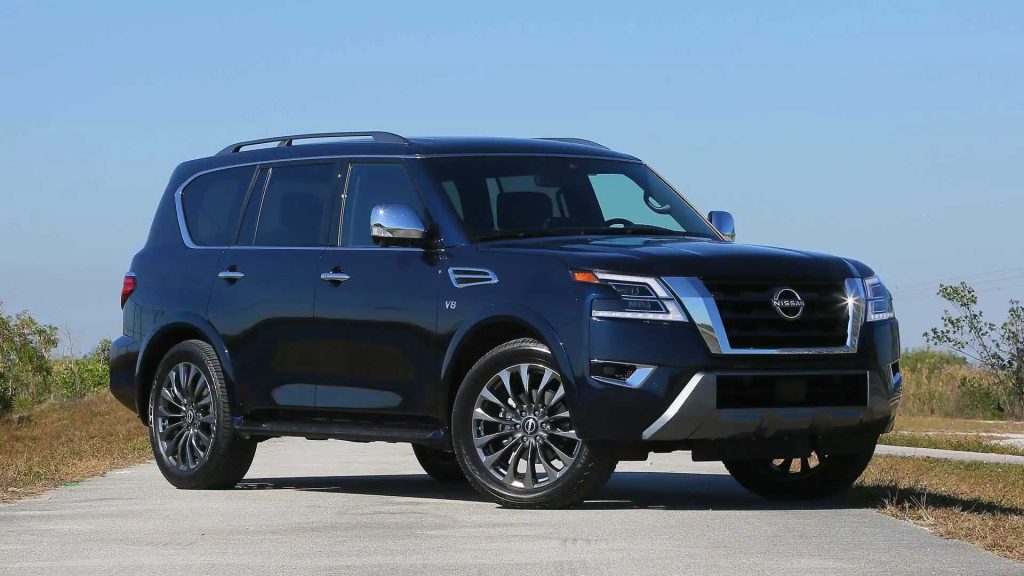
With the Chevrolet Tahoe and Suburban already dominating the segment, creating another SUV based on the new Titan didn’t seem viable. Instead, Nissan took a different approach when designing the 2017 Armada—drawing inspiration from another rugged, body-on-frame model already in its global lineup: the Patrol.
Prior to the second-generation Infiniti QX56 (now the QX80) launching in 2011, the Nissan Patrol had never been sold in the U.S., yet it enjoyed a strong international reputation.
The Patrol originally debuted in the 1950s as a durable, low-cost off-roader, and like the Toyota Land Cruiser, it has steadily evolved into a more refined and feature-rich vehicle over the decades.
The modern Patrol is equipped with advanced features like locking differentials and a hydraulic body control system, the latter of which “essentially disconnect[s] the rig’s anti-roll bars for better off-road articulation like the Lexus LX 570.”
To editorialize for a moment, that’s somewhat of a letdown. Even though the Patrol was previously unavailable in the American market, Nissan is still widely recognized for its off-road legacy.
The brand even offers off-road-focused Pro-4X trims for models like the Titan and Frontier. Choosing not to extend similar capabilities to the Armada feels like a missed opportunity.
That said, Nissan’s decision is understandable. Evaluated against mainstream competitors such as the Chevrolet Tahoe—“which long ago gave up any pretense of real off-road ability”—the new Armada stacks up well.
It’s powered by Nissan’s Tennessee-assembled “Endurance” 5.6-liter V-8, which generates 390 hp and 394 lb-ft of torque. In our fully-loaded Armada Platinum tester, this engine is paired with a seven-speed automatic transmission and a four-wheel-drive system.
The V-8 is described as “brutish in the best-possible way,” providing both strength and smoothness. With ample torque and a confident exhaust note, the Armada accelerates forcefully, its hefty frame squatting as it surges forward.
The seven-speed transmission operates efficiently and contributes to quieter highway cruising by keeping engine speeds around 1,500 rpm. Despite its sizeable 20-inch wheels, the Armada delivers a decent ride quality, though those same wheels hinder its handling.
When asked to take a corner, the vehicle behaves clumsily, “flop[ping] around like a fish out of water,” with vague steering feel and pronounced body roll—traits long since improved upon in rivals like the Tahoe and Ford Expedition.
These shortcomings in handling showed up in our testing results. During figure-eight testing, the Armada recorded a best lap of 28.4 seconds at 0.59 g average—“a tenth of a second and 0.3 g shy of a comparably equipped four-wheel-drive Tahoe LTZ.” Still, the Armada makes up ground in straight-line performance.
It reached 60 mph in 6.3 seconds and ran the quarter mile in 14.9 seconds at 94.0 mph. Comparatively, “the very same Tahoe, which has a 5.3-liter V-8 with 355 hp and a six-speed automatic, needed 7.0 seconds to hit 60 mph and 15.4 seconds to finish the quarter mile at 90.6 mph.”
Only the 2015 Ford Expedition EL has posted similar numbers in our tests. While we haven’t tested the shorter variant of the EcoBoost-powered Expedition, the longer, 365-hp version—featuring a twin-turbocharged 3.5-liter V-6—does “0-60 mph in 6.5 seconds and the quarter mile in 15.1 seconds at 90.3 mph.” As for braking, the Armada is middle-of-the-pack, stopping from 60 mph in 128 feet.
Ford Expedition and Expedition EL
SUVs that come with roof racks often offer different styles depending on the trim level, and the Ford Expedition is a strong example of that trend.
The base XLT trim includes black luggage-rack side rails and black crossbars, while higher trims like the Expedition King Ranch and Expedition Platinum combine the same black crossbars with chrome-finished side rails. The extended-length Expedition EL uses the same approach but offers more interior storage space to go with it.
The standard Expedition provides a maximum cargo capacity of 108.3 cubic feet, while the EL version ups that number to 130.8 cubic feet. Even with all seats in use, the Expedition EL offers 42.6 cubic feet of rear cargo space, compared to just 18.6 cubic feet in the regular-length version.
Who could have predicted that full-size SUVs would not only weather the storm of $4-per-gallon gas and a major economic downturn, but actually come out stronger less than ten years later?
Yet, that’s the current reality for models like the Ford Expedition, which is now enjoying some of its highest sales in the past decade—a resurgence fueled by a stronger economy and a timely refresh introduced last year.
That refresh brought along several mechanical enhancements. The Expedition traded in its V-8 for a powerful turbocharged V-6, adopted an adaptive suspension system, and upgraded to a more modern infotainment interface. It also incorporated a range of upscale design elements, though it stopped short of following the Ford F-150’s path by going all-in with a new aluminum body.
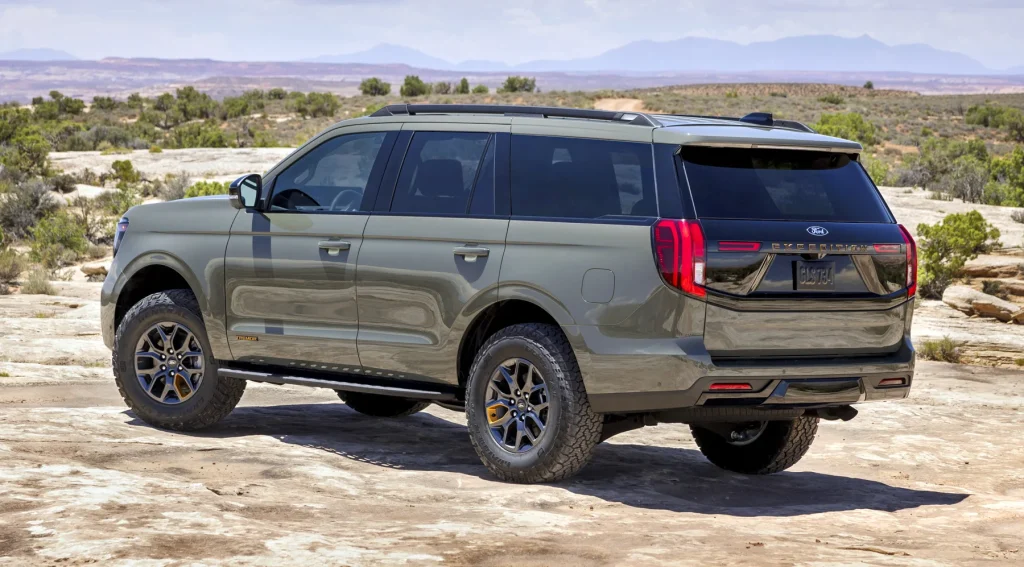
Ford’s updates to the Expedition couldn’t have come at a better moment. Around the same time, General Motors was rolling out improvements across its lineup of full-size SUVs, focusing on fuel-efficient powertrains, enhanced safety and tech features, and updated styling. Among the Expedition’s key competitors are those GM vehicles: the Escalade, Yukon, Tahoe, and Suburban.
In our evaluations, the Expedition scores higher than those GM SUVs—as well as most other full-size options—though its edge comes from steady refinement rather than a dramatic overhaul.
This evolution is evident in its exterior design. The Expedition maintains the strong, boxy shape typical of a traditional SUV, but it also features a few more refined and fluid styling cues reminiscent of the design language Ford introduced in the mid-2000s.
Toyota 4Runner
Designed as a rugged counterpart to Toyota’s crossover offerings, the Toyota 4Runner features the same tough body-on-frame construction commonly found in domestic SUVs equipped with roof racks—and it includes a roof-rack system of its own.
What sets the 4Runner apart is its stylish approach to utility: the roof is outfitted with silver-painted rails, which are matched with “silver endcaps (SR5 and Limited) or black caps (Trail and TRD Pro).”
As is often the case with SUVs, the crossbars aren’t included as standard. However, Toyota simplifies the process by offering them through a Convenience Package available from Toyota Genuine Accessories.
This package includes the crossbars, “a chromed exhaust tip and alloy wheel locks,” though all of these items can also be purchased individually as standalone accessories.
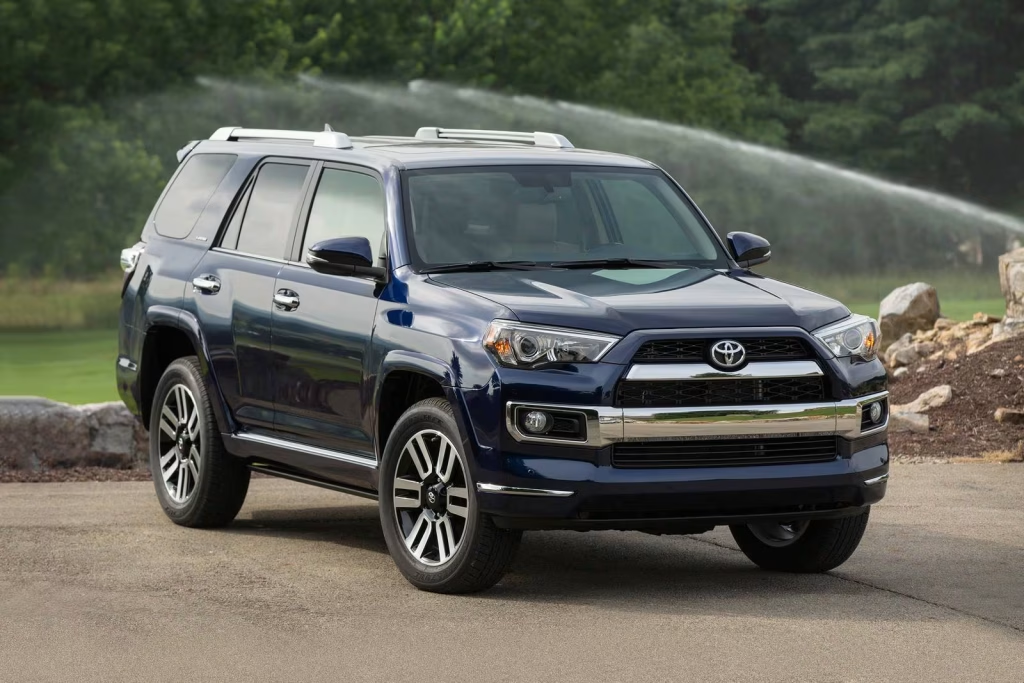
The 2025 Toyota 4Runner has an off-road focus, but it still feels composed and confident both in the city and on the highway. Its steering is precise, and it feels surprisingly maneuverable thanks to a tight turning radius. The ride is composed but not as refined as many classmates.
The 4Runner’s base engine is a 2.4-liter turbo-four with 278 horsepower and 317 pound-feet of torque. It delivers plenty of power for daily driving and feels suitable for off-roading. The available hybrid powertrain pairs an electric motor with the turbo-four, producing a combined 326 horsepower and 465 pound-feet of torque.
The hybrid feels peppier off the line, but the extra weight can make the handling more cumbersome. Each powertrain is paired with an eight-speed automatic transmission. Rear-wheel drive is standard, and four-wheel drive is available.
Also Read: 10 Cars With Best Dash Designs That Bring Innovation
Cadillac Escalade and Escalade ESV
Ranked among the most premium SUVs with roof racks, the Cadillac Escalade and its extended-wheelbase counterpart, the Escalade ESV, deliver an unmatched blend of luxury and utility.
As the newest iteration of Cadillac’s iconic full-size SUV line, these models feature “big bright grilles and a blazing bevy of exterior LED lights,” which is fitting, considering their roof rails come standard with an attention-grabbing chrome finish.
Adding to the upscale presentation are optional black crossbars—“like the black-tie accents of a sophisticated tuxedo”—along with an available set of new 22-inch wheels featuring “a seven-spoke design, painted finish, and chrome inserts.”
But make no mistake: the Escalade isn’t just about looks. Cadillac offers a wide range of cargo-management accessories to complement those stylish rails, including “a hard cargo container, a ski rack, and a bicycle holder.”
When Cadillac introduced the Escalade as a 1999 model, more than a few critics believed the brand was attempting to satisfy a demand that didn’t actually exist. However, the luxury SUV market quickly gained traction, and today, the Escalade continues to thrive.
The segment for large luxury SUVs is now filled with strong contenders, and staying competitive grows more challenging each year. Still, fresh off a full redesign last year, the Cadillac Escalade has reclaimed its position as a top seller, a testament to the model’s lasting appeal.
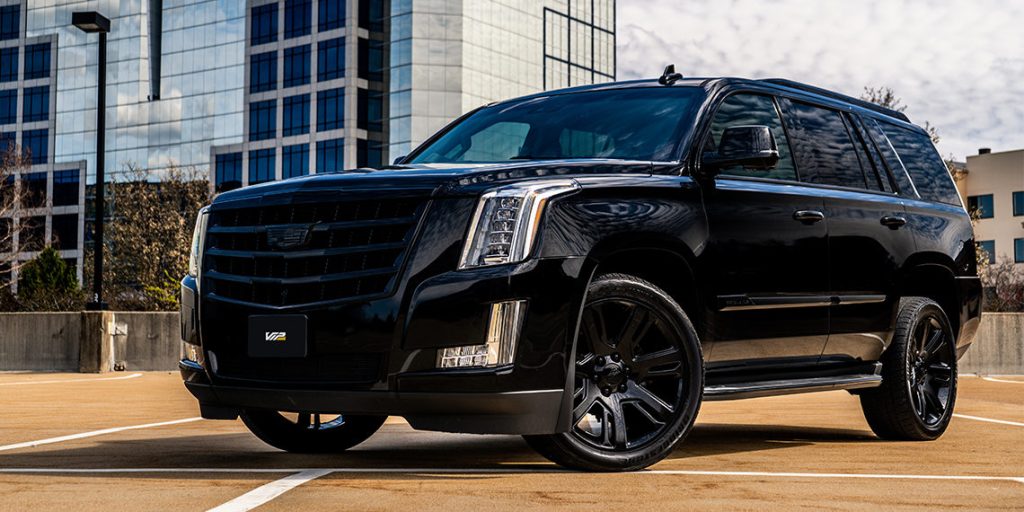
The Escalade’s exterior design remains unchanged. Its commanding dimensions are underscored by the bold, squared-off styling introduced for 2015, complete with more prominent design flourishes. Inside, a sleek and modern dashboard layout helps set this Escalade apart from its more utilitarian predecessors.
One of the most significant updates for 2016 is the improvement to Cadillac’s frequently criticized CUE touch-based infotainment system, which now features a faster processor and a more precise voice-recognition interface.
Additionally, a lane-departure intervention system is newly available, and for the first time, every Escalade model comes standard with an eight-speed automatic transmission.
That said, the Escalade’s truck-derived platform does result in a few drawbacks. The high load floor in the cargo area and the relatively tight third-row seat are direct consequences of that architecture, which it shares with Chevrolet and GMC’s full-size SUV offerings. Similarly, the ride quality can fall short of luxury expectations, occasionally coming across as too rough and unsettled.
Nevertheless, the Escalade remains a compelling option in the realm of three-row traditional luxury SUVs, standing up well against rivals like the 2016 Lincoln Navigator, Lexus LX 570, and Infiniti QX80. Still, the 2016 Mercedes-Benz GL-Class edges out the Escalade with superior driving dynamics, improved fuel economy, and a more functional third row.
Meanwhile, the two-row Land Rover Range Rover delivers an unmatched combination of upscale prestige and genuine off-road capability. Ultimately, our impression of the newest Escalade is somewhat reserved, but for shoppers seeking a brawny SUV loaded with luxury features, this Cadillac still delivers the goods.
Infiniti QX80
As the luxury-focused sibling of the Nissan Armada, the Infiniti QX80 elevates its standard roof rails with a distinctly upscale appearance.
To ensure it competes effectively in the high-end SUV segment, the QX80 Limited is outfitted with roof hardware—both side rails and crossbars—highlighted by “a dark chrome finish that matches the vehicle’s grille surround, its foglight frames, and the distinctive side vents on its hood.”
Under the hood, Infiniti equips this full-size SUV with a powerful V8 engine producing “400-horspower [sic] and 413 lb.-ft. of torque.” Thanks to that, this plush, leather-trimmed luxury hauler boasts a towing capacity of “an impressive 8500-lb.”
The consensus among the team regarding the Infiniti QX80 is that it’s quiet, powerful, luxurious—and, to put it bluntly, not much to look at.
I might be the only editor at One Autoweek Tower who doesn’t immediately cringe at the QX’s hefty, bulbous exterior, whether it’s painted in the people-swallowing purple of our former long-term tester or the deep midnight blue of the current one. I’m not saying I love the design—but let’s be clear, it’s no Pontiac Aztec either.
That said, I’ll admit the front end is a tough sell. There’s a definite droopiness to it—part Cro-Magnon, part schnauzer—that makes it look a bit odd.
The headlights not reaching all the way to the hood is a design choice that doesn’t quite land, and perhaps a brighter chrome grille would improve things, though I could be off base. Still, I find the side profile attractive, and the rear styling works just fine.
Powering the newly named QX80 is a burly 5.6-liter V8—because let’s be honest, there’s no way a V6 could effectively move a nearly three-ton machine like this.
The engine generates 400 horsepower at 5,800 rpm and 413 lb-ft of torque at 4,000 rpm. It’s paired with a seven-speed automatic transmission, and our test vehicle sent power to all four wheels.
The Infiniti/Nissan radio setup is quietly one of the best in the business. At the top of Infiniti’s SUV lineup, the QX80 competes with other full-size, three-row luxury SUVs including the Cadillac Escalade, Mercedes-Benz GLS, and Lexus LX.
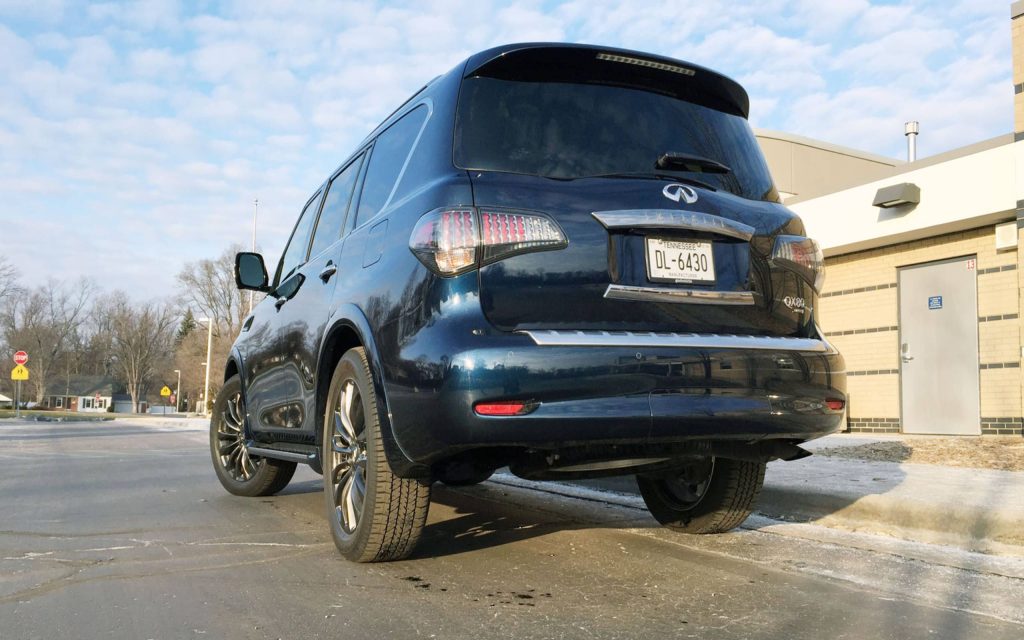
On the road, Infiniti’s V8 feels like it’s putting out more than its stated 400 horsepower. If I had to guess based on seat-of-the-pants feel, it seems closer to 450. Acceleration is smooth, and while gear changes aren’t completely seamless, they are quick and soft.
The seven-speed gearbox works hard to keep revs low to help with fuel economy, and when you put your foot down on the highway, it hesitates—often requiring two downshifts rather than one, and only when the pedal hits the floor. A little more brake pedal sensitivity wouldn’t hurt, either.
Even with massive wheels and tires, the suspension does an admirable job of soaking up most road imperfections, though some noise still seeps in. With low-profile tires, even minor disturbances like tar-filled expansion joints are audible inside.
Beyond that, the QX80 maintains excellent insulation from wind and road noise. If you make a quick steering correction, the vehicle rocks a bit, but it doesn’t float any more than its rivals. Parking can be a challenge due to the sheer size, but the Around-View camera system significantly eases the process.
I recall how our previous long-term QX beeped every time it brushed a lane marker. This latest model doesn’t exhibit the same behavior. Whether that’s due to the system being disabled or simply no longer included, I’m not sure. There’s a subtle warning light now, but it’s far less obtrusive.
These full-sized SUVs require some breathing room. Sometimes you need to nudge toward the edge of the lane or even cross the line slightly for clearance. As long as the driver is attentive—which, granted, is asking a lot these days—they should be able to manage it without the vehicle acting like a backseat driver.
Inside, the QX80 offers nearly the cabin space of a pickup, minus the open bed. I was able to transport a comically large shoebox to a friend’s place with just the third row folded flat. Personal storage throughout the interior is plentiful.
Fit and finish inside the cabin are impressive. Materials look and feel premium, panel gaps are tight, and the seats offer good overall comfort.
Infiniti and Nissan’s infotainment systems remain some of the easiest to use on the market. The high seating position provides a commanding view of the road, though getting in does require a bit of a climb.
One downside to the seating is the lack of lateral support, particularly around the shoulders. If you decide to drive with any enthusiasm, you’ll end up bracing against the door or center console. Then again, this vehicle isn’t really meant for spirited cornering.
The brown “baseball mitt” leather is one of my favorite interior color choices, and I’m a big fan of the matte wood trim as well. Honestly, this is close to my ideal interior for a luxury SUV.
Sure, the $90,000 sticker price may sound steep, even for this Limited model, but a base QX80 starts around $65,000. The Mercedes GLS spans a similar price range, and the Cadillac Escalade starts at $74,000, climbing well into the $90Ks.
Those two definitely have more conventional styling, but in terms of capability and features, the Infiniti doesn’t concede much.
Lincoln Navigator and Navigator L
Lincoln, the luxury division of the Ford Motor Company, has teamed up with Thule to outfit its SUVs with enhanced roof rack capabilities. Both the Lincoln Navigator and its extended-length counterpart, the Navigator L, come standard with “chrome side rails, black crossbars and black end caps.”
For customers who lead active lifestyles, Lincoln offers branded cargo accessories manufactured by Thule—one of the most trusted names in the industry for “kayak carriers, ski/snowboard carriers, and various storage boxes.”
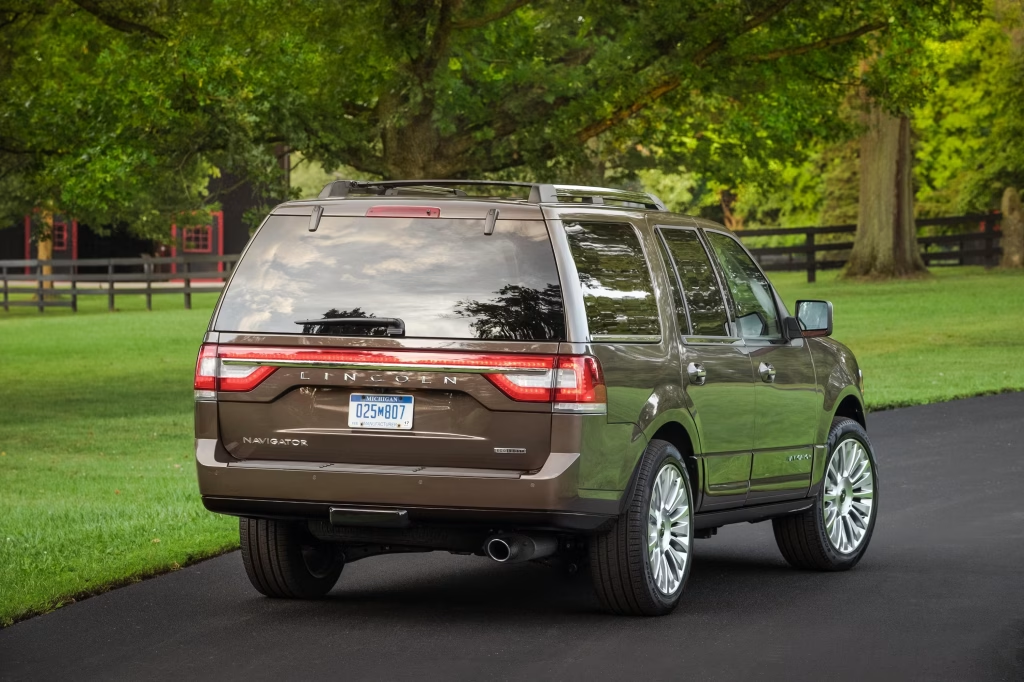
These accessories expand the already generous cargo capacity of the Navigator, making it a smart option for those who want to protect the SUV’s upscale interior from the wear and tear of transporting large or dirty gear.
The cabin itself is lined with high-end materials, including “lots of rich leather, even in the heated second-row captain’s chairs”; naturally, no one wants to fold those seats away just to make room for extra cargo.
GMC Yukon and Yukon XL
GMC has a reputation for combining Professional Grade engineering with Denali-level luxury, and its Yukon and Yukon XL SUVs with roof racks are clear reflections of that dual personality. All versions of these full-size SUVs come standard with roof rails, while crossbars are available for those who need additional cargo-carrying options.
The Yukon XL represents the long-wheelbase version of the nameplate, ideal for those seeking more space. Customers who select the top-tier Denali trims are treated to “chrome-accented luggage rails,” which add a touch of sophistication.
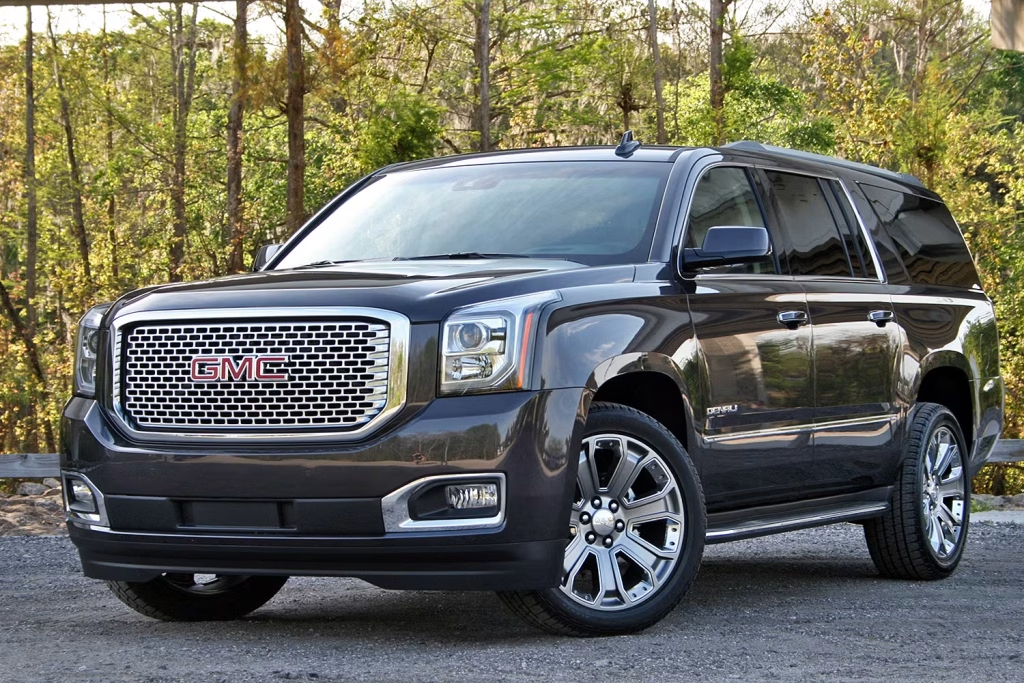
The Yukon’s infotainment system has been upgraded to include “smartphone-integration to their previously standard mobile Wi-Fi service,” and the SLT trim now benefits from a “hands-free, power-opening liftgate.” On the safety front, GMC debuts “lane-keeping assistance and IntelliBeam headlamps,” further boosting the Yukon’s all-around appeal.
Toyota Sequoia
For shoppers seeking SUVs with roof racks to accommodate family-scale outings and weekend getaways, the Toyota Sequoia stands out as a go-to option.
This full-size, three-row SUV from Toyota offers room for up to eight passengers and comes with built-in versatility, including “not just a roof rack, but eight-occupant seating and a trailer hitch that’s directly integrated into the Sequoia’s tough steel frame.”
That hitch enables the Sequoia to tow as much as 7,400 lb. Toyota further supports towing capabilities with a transmission tow/haul mode and trailer sway control, ensuring confident handling under load.
And when it comes to tech features, the Sequoia keeps pace with the competition. “Entune technology is standard, and navigation, JBL audio, and the Entune App Suite are all available,” making it a solid mix of brawn and brains.
The Toyota Sequoia has a starting price of $48,400, with higher trim levels pushing the cost up to more than $67,000. If you’re looking to save a significant amount of money, especially on a base model with minimal options, purchasing a used Sequoia can offer considerable savings.

That said, there are some key advantages to opting for a brand-new model. Notably, the Sequoia introduced the Toyota Safety Sense P package as standard for the first time.
This means that every Sequoia comes equipped with adaptive cruise control, lane departure warning, and forward collision warning with brake assist. In addition, the model features mild updates to both its interior and exterior design. These combined improvements make the Sequoia a more compelling choice compared to earlier versions.
Alternatively, it’s possible to save money while still purchasing a brand-new vehicle. The Toyota Highlander has a base price of only $31,030. Although the three-row Highlander doesn’t offer as much interior space as the Sequoia, it surpasses its larger counterpart in terms of fuel efficiency, interior refinement, and ease of handling.
Lexus GX 460
As expected from a luxury brand like Lexus, the GX 460 offers a refined driving experience with a premium cabin layout. Standard amenities include “10-way power-adjustable front seats, a nine-speaker Lexus audio system, and even a powered moonroof.” That said, some may wonder whether an SUV with a sliding moonroof can also support a roof rack.
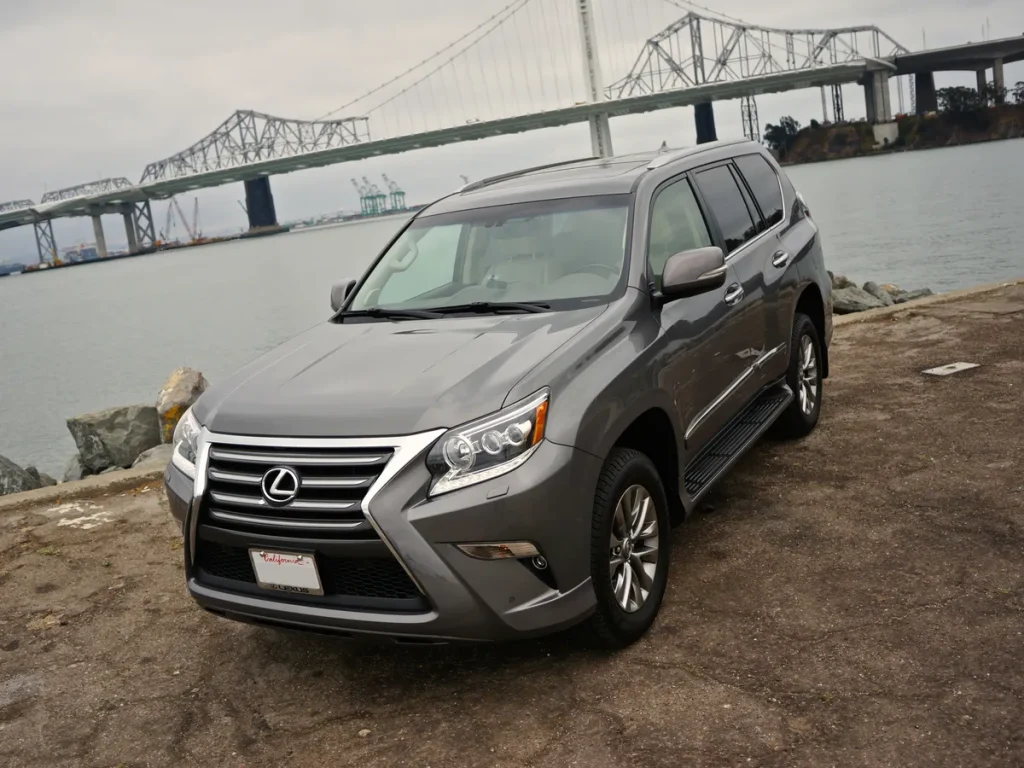
The GX 460 answers with a confident yes. Not only does it come equipped with roof rails, but it also delivers legitimate off-road performance through features such as “full-time 4-wheel drive, crawl control, a Kinetic Dynamic Suspension System,” and more—all without compromising its upscale offerings.
Drivers can also enjoy “Mark Levinson surround-sound audio, heated and cooled seating, and a comprehensive Driver Support Package of active safety measures,” proving that ruggedness and refinement can absolutely coexist.

